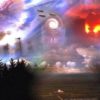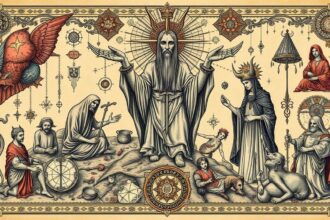As April 20 approaches, a growing wave of speculation and concern has once again surged across online communities, faith-based circles, and fringe observers of global patterns. Pastors and prophetic voices have long marked this date with an air of caution—declaring it as a potential window for the ominous Three Days of Darkness, a prophesied event deeply rooted in spiritual and esoteric traditions.
But this year, the atmosphere feels even more charged than before. The real concern isn’t just about what could happen on April 20—it’s about what might begin even sooner. According to ancient occult timelines and grim historical patterns, April 19 may in fact be the true catalyst for what lies ahead.
April 19: The Start of the Occult Blood Ritual Season
Today is April 19, a date that holds chilling significance in certain dark esoteric belief systems. This day marks the beginning of what some refer to as the “Blood Sacrifice to the Beast,” a 13-day period allegedly rooted in the ancient practices of Baal and Nimrod worship. According to occult lore, this ritualistic window culminates on May 1—also known as Beltane, a pagan holiday associated with fire and fertility rites.
The significance of April 19 is particularly disturbing: the ritual is said to require a human sacrifice, often linked to fire or a fiery event. It’s no coincidence, say conspiracy theorists and historians of occultism, that so many violent incidents, particularly those involving explosions or fire, seem to occur around this time of year.
Ancient texts, such as those found in Ugaritic inscriptions, describe Baal’s temples adorned with fire altars. While mainstream historians argue that these practices ceased with the spread of monotheistic religions, some fringe theories propose that secret societies have preserved these rituals, adapting them to modern contexts.
A Historical Pattern of Fire and Terror
The period from April 19 to May 1 is significant in conspiracy lore due to its alleged alignment with the Baal cult’s sacrificial calendar. April 19 marks the beginning, where a human sacrifice, often symbolically or literally tied to fire, is said to initiate the cycle. The culmination on May 1 coincides with Beltane, a Celtic festival associated with fire and renewal, suggesting a possible syncretism of ancient traditions.
Whether coincidental or orchestrated, many major catastrophes and terror events have fallen within this window:
- Waco Siege (April 19, 1993): The deadly conclusion to the standoff between the FBI and the Branch Davidians occurred in a fiery blaze.
- Oklahoma City Bombing (April 19, 1995): A devastating terrorist attack on a federal building, killing 168 people.
- Columbine High School Massacre (April 20, 1999): A school shooting that shocked the United States and the world.
- Notre-Dame Cathedral Fire (April 15, 2019): Though not on April 19 specifically, this iconic blaze fits the fire-related symbolism and timing patterns of the so-called sacrificial calendar.
These events, especially those involving fire, lend credibility—at least in the minds of theorists—to the idea that certain global players or shadowy networks might be orchestrating incidents that align with an ancient sacrificial calendar.
Are Ritual Sacrifices Still Happening Today?
Although the ancient civilizations of Canaan and Babylon were long ago destroyed, many believe their dark spiritual practices never truly disappeared. Instead, they may have gone underground—kept alive by secret societies or powerful cults embedded in influential global institutions.

The belief is that modern-day elites or occult groups still adhere to ancient rites, performing symbolic acts of power and control during key dates on their sacred calendar. Whether literal or metaphorical, these alleged rituals are said to manifest through fire, blood, chaos, and fear.
Modern Manifestations and Conspiracy Theories
Conspiracy theorists claim that the Baal cult’s modern adherents occupy influential positions in global politics, finance, and media. These individuals, they argue, orchestrate fire-related terrorist attacks or accidents to fulfill ritual obligations. The Notre-Dame fire, for example, is cited as a potential act of arson, though official investigations attribute it to accidental causes, such as electrical faults.
Other incidents linked to this period include:
- Gas Station Explosions: Hypothetical scenarios where crowded public spaces become targets for fire-based attacks.
- Arson of Cultural Landmarks: Speculation about future fires targeting ancient cathedrals or world-famous buildings.
Critics dismiss these claims as unfounded, arguing that correlation does not imply causation. However, the persistence of such narratives fuels public curiosity and concern.
Apocalyptic Predictions for April 19 – May 1, 2025
As we approach April 19, 2025, some fringe groups predict a surge in fire-related incidents, potentially signaling apocalyptic events. Pastors and self-proclaimed prophets have previously declared “three days of darkness” during this period, though such prophecies have failed to materialize. Nevertheless, the following scenarios are speculated:
- Arson of Significant Structures: Another historic cathedral or culturally significant building could be targeted, mirroring the Notre-Dame fire.
- Public Space Attacks: Crowded areas, such as markets or transportation hubs, may face fire-based incidents, possibly disguised as accidents.
- Global Escalation: Some theorists suggest that these events could trigger broader geopolitical or societal unrest, aligning with apocalyptic narratives.
While these predictions lack empirical support, they resonate with those wary of global conspiracies and esoteric agendas.
Precautions for the Public
Given the speculative nature of these claims, it’s prudent to approach them with skepticism but remain vigilant. For those concerned about potential risks during April 19 – May 1, 2025, consider the following precautions:
- Avoid Crowded Places: Limit visits to busy public spaces, such as malls, stadiums, or tourist attractions.
- Stay Informed: Monitor news for unusual fire-related incidents or security alerts.
- Plan Travel Wisely: Postpone non-essential long-distance trips until after May 1.
- Home Safety: Ensure smoke detectors and fire extinguishers are functional in your home.
These measures are general safety practices that apply regardless of conspiracy theories, promoting preparedness without panic.
Debunking or Validating the Claims
Mainstream historians and scholars reject the notion of a surviving Baal cult orchestrating global events. The lack of concrete evidence, reliance on anecdotal correlations, and absence of verifiable sources undermine these theories. However, the psychological appeal of such narratives lies in their ability to explain chaotic events through a lens of hidden control.
For those intrigued by these ideas, critical thinking is essential. Cross-reference claims with reputable sources, such as academic journals or official reports, and question the motives behind sensationalist predictions.
Final Thoughts: Truth, Symbolism, and Spiritual Warfare
The alleged Baal fire cult and its 13-day ritual cycle from April 19 to May 1 captivate the imagination of conspiracy enthusiasts. While historical Baal worship is well-documented, its modern continuation remains speculative. Fire-related incidents like the Notre-Dame blaze fuel these theories, but official explanations often point to mundane causes.
Regardless of whether these apocalyptic forecasts come true or not, they point to a deeper truth: the battle between light and darkness is not just religious metaphor—it plays out in the real world through events, symbols, and narratives that shape our lives.
Whether you’re a spiritual seeker, a skeptic, or someone simply curious about the strange synchronicities in our world, the period of April 19 to May 1 invites deep reflection. It reminds us to stay awake—not just in a physical sense, but also spiritually and emotionally.
Stay safe. Stay aware. And above all, stay grounded in truth.

















